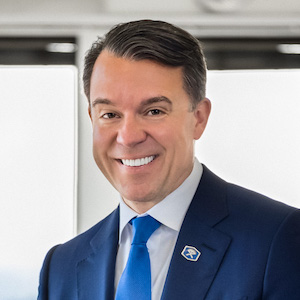Dale Yake, CEO of PT Solutions, has been a transformative force in the field of physical therapy. With a deep commitment to personalized patient care and improving the health care ecosystem, Dale founded PT Solutions in Eufaula, Alabama. Under his leadership, PT Solutions has grown to encompass over 1,800 therapists and 550+ clinics across 25 states, establishing numerous health system partnerships.
Health Evolution interviewed Dale about his journey with PT Solutions, the impact of his leadership on the organization’s growth, and how he envisions the future of physical therapy within the broader health care landscape.

Dale, welcome to the Health Evolution Fellowship. We’re excited to have your expertise, leadership, and passion in this community. Let’s start with your undeniable passion for physical therapy—what ignited and continues to fuel it?
My passion for physical therapy was ignited during my time as a Division 1 college athlete, and it was further fueled by suffering multiple knee injuries. I recognized an opportunity to be a part of a patient-connected profession, and I experienced firsthand the incredible impact physical therapy (PT) could have on a patient’s long-term outcomes. Once a practicing clinician, I was motivated by how much opportunity there was to validate and advance the science of the profession.
This experience taught me the importance of personalized patient care and the need to improve how patients navigate the broader health care ecosystem. When I founded PT Solutions in Eufaula, Alabama, I focused on patient-centered care and acted as a care navigator, connecting patients to primary and specialty care they required. Over the years, our practice has grown to encompass 1,800+ therapists, 550+ clinics across 25 states, and numerous health system partnerships. Our goal is to continue driving connectivity and scalability between physical therapy, primary, and specialty care through these partnerships.
Given your national perspective, how effectively are leaders across health care realizing the potential of PT? Do you see a lot of misconceptions or outdated perceptions?
There are two angles to approach this question – PT as a strategic ambulatory asset and PT as a valuable service to enhance quality of care delivery – both are important.
From a national perspective, health care leaders are increasingly recognizing the potential of physical therapy in enhancing patient outcomes and overall health care delivery. However, misconceptions still persist in some quarters if leaders or providers view it simply as a post-acute service as opposed to a valuable resource across the care continuum. At PT Solutions, we prioritize the whole patient and recognize the multifaceted nature of their recovery journey, whether it involves regaining mobility, returning to sports, post-operative rehabilitation, or achieving peak performance. By building a comprehensive service and care plan around the patient, we can address their holistic needs rather than focusing solely on one aspect of their care or injury. We do this through advancing an evidence-based approach to care across our platform of clinics and health care partners.
Second, historically, systems have underinvested in PT with the perception that it is an ortho service line cost center. PT and OT will be a $90B market in 2030. The true strategic potential of PT is to think of it as part of a primary care, ambulatory strategy to improve access to care and compete for market share upstream. As leaders lean into their outpatient strategies, I would encourage them to prioritize PT. Research has shown that a PT patient delivers a higher downstream revenue impact for the system than other traditional outpatient access points, like primary care and urgent cares. A comprehensive, competitive ecosystem must include PT.
Investments in PT today will prove to be a no regret strategy for health system leaders – it enhances care delivery, optimizes access to care across a community and can be a valuable asset in FFS or value-based care payment models.
Is the current patient journey structured to unlock the benefits of physical therapy? Are there big disconnects standing in the way—and are there ramifications of continuing the status quo?
I believe health care models are shifting and the drivers of decision making are constantly being shuffled. With the advancing consumerism, focus on cost and the resultant expectations of value from health care, I have seen a shift of where physical therapy sits over my 30+ year career. Physical therapy now is becoming more front-of-care as opposed to the back end of care. Both inside the profession and out, there are barriers that remain to getting patients where they need to be quickly to avoid a cascade of condition.
But by leveraging PT effectively, health care leaders can optimize patient outcomes, improve overall health care delivery and cost, and offer patient centered care. And this can strengthen relationships between patients and health systems. In a competitive market, retaining patients within the network is crucial. We can support patient retention by prioritizing convenience and customer service, keeping them within the network for PT services, enhancing patient loyalty, and reducing the risk of leakage. Attracting new patients to the system becomes the next step. Our care advances the perspective of consumer-centered, evidence-driven care, and we become very competitive within the market to expand the patient base and build trusting relationships with referring providers through our network development team.
So, I don’t believe we are in a status quo period. Those willing to view the ecosystem differently will be the providers of choice. Hence why PT Solutions partnering with health systems has been so successful for our partner and their communities they serve. These partnerships in tandem with PT Solutions’ ability to accept direct access patients allows for an increase in access points and expedited care to the patient.
Efforts to design a better patient journey and experience are occurring at a time when leaders have an expanding set of tools for redesigning care delivery. How do you see digital health influencing physical therapy? And more broadly, how would you describe the PT landscape right now when we’ve seen so much consolidation of other aspects of health care?
The PT market is incredibly fragmented, and this historically has been challenging for health systems to build a sustainable PT partnership strategy. Many feel they must resort to employment or the status quo. There are challenges to delivering a high-quality PT service and this is where a robust partnership approach helps.
From our experience, establishing strong partnerships with health systems is paramount in shaping the landscape of physical therapy amid evolving care delivery methods. And the most effective strategic partnerships share a few hallmarks:
1. Clinical Partnership: It’s crucial to transcend the vendor-client dynamic and become genuine clinical services partners. Embedding ourselves within the health system’s culture fosters collaboration and ensures alignment with their mission and values. We aim to enhance clinical engagement, seeking more involvement from Chief Physician Executives, as well as leaders of MSK and Ortho.
2. Growth Strategy Alignment: PT services thrive on local presence and community integration. Our growth strategy prioritizes access to care and community engagement, reflected in our presence at schools, universities, and community events. Building density in clinic locations and support services is essential for convenience and availability, tailored to each market’s needs. We partner closely with Chief Strategy, Chief Marketing and Ambulatory executives across our partners to ensure the expansion and branding strategy aligns with the system’s near and long-term growth and market share objectives.
3. Innovation: Digital engagement being just one of those trends, but a more aligned system can respond with better adaptation to care elements that meet patient needs more eloquently.
4. Governance and Communication: Effective governance, communication, and accountability mechanisms are vital for successful partnerships. Transparency, visibility, and inclusion in the health system’s strategy enhance collaboration and drive better outcomes.
By emphasizing these principles in our partnerships, we navigate the evolving landscape of health care delivery, ensuring PT’s integral role in patient care and experience.
Building on how broader market trends are affecting PT, I have to imagine that workforce pressures have been top of mind. How are you working to ensure a thriving PT workforce and train the next generation?
Workforce dynamics in physical therapy are not new to the profession as it has been a profession undersupplied since my entrance. Demand for services and limitation in production of quality physical therapists in the academic realm remain an issue. PT Solutions is supporting wider professional issues in partnership with our academic partnerships around the country examining training models and entrance requirements.
We also offer an APTA accredited residency program, a clinical innovation program, an employee incentive program to drive engagement, and we believe in investing in leadership and development opportunities for our employees. Currently, our leadership and communication training, clinical residency, mentorship and clinical outcomes research programs are an industry leader attracting high-quality, entrepreneurial professionals aimed at improving patient care journeys and their own professional journey. Attracting talent with a national approach and outlining long-term career development has been a success for PT Solutions. And by being an employer of choice with 20-years of experience and national presence, we can help our partners, who are facing workforce shortages and rising labor costs.
Finally, as you know, advancing cross-industry collaboration is central for leaders in the Health Evolution community. What do you see as the top opportunities for more effective collaboration in physical therapy?
I talk with health system leaders every day, and many understand they should invest in PT to expand access and reduce system leakage, but with competing initiatives it becomes deprioritized over time. I see the top opportunity for system leaders to be the openness to partner in this space, as opposed to the traditional calculus of “build vs. buy”.
And when we partner effectively, we can make great strides in addressing our PT access challenges. For example, capital investment in PT facilities is often insufficiently allocated to meet community needs – especially in a retail-based strategy. Partnership can offer scalable solutions and the capex to grow quickly; for example, with a health system partner of ours in Illinois, we opened 22 new clinics in 22 months. It’s hard to imagine that result outside of an effective collaboration.
The most successful and productive cross-industry collaborations I’ve seen are those where both parties have aligned goals, values and respect for the strengths and competencies each entity brings to the partnership. This is what we strive for at PTS.










